Situated in the heart of the County Tipperary countryside, Nenagh Golf Club is a wonderful 18 hole course that is a joy to play. It originally started out as a 9 hole, Alister McKenzie designed course. The layout was considered one of the best 9 hole courses in Munster and remained substantially unchanged until 1973, when Eddie Hackett designed its first 18 hole course.
When I arrived at the club car park I was greeted by the Course Superintendent, Mark O’Donohue, who showed me around the course. The ground was very firm and dry, mainly due to the fact that Nenagh golf course lies on a sandy, gravel bed within rolling esker undulations. This means that the course mostly remains dry, especially in winter. If you were not aware of the sand and gravel lying underneath, the rabbits living on the course would soon remind you. They have dug many burrows around the course revealing beautiful silver sand.
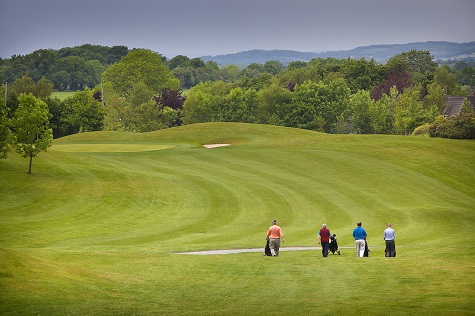
The 9th hole
History
The club was formally established as a 9 hole course in 1929, designed by Alastair MacKenzie for a fee of £15 & 10 shillings. There is evidence to suggest that Nenagh had a golf course back in 1890, probably on or near the same site as the present course. It is thought that the1890 course was mainly used by the military as Nenagh was formerly a garrison town. Access to the course was relatively easy back then as it bordered the Ballybrophy – Nenagh railway line just like the course does today. An extract from The Irish Golfers Guide circa 1905 states:
Nenagh Golf Club (Co. Tipperary)
Founded 1890. A nine holes inland course, within half a mile of Nenagh Station (railway) G.S.W.R.
There is another reference to the club being in existence on the same site prior to 1929 as a receipt was discovered stating the following:
Received from The Nenagh Golf Club per M. Gleeson Solicitor. The sum of one pound three shillings on account of work done in taking down and removing the Golf Pavilion at Beechwood. Dated 17th February 1923. Signed: Wm. Costello.
It is at Beechwood where the present club is located so one can assume that the club existed before it formally registered with the GUI in 1929.
The club originally rented land but within ten years of its recognized formation, in 1929, the club was able to buy the property that the course was built on and were now no longer tenants but owners of the land. The area of land it bought outside the 9 hole layout was rented out for grazing. In the early 1970’s this extra piece of ground came to the club’s rescue, as it was used to extend the course to 18 holes. The club employed the services of Eddie Hackett to design the new holes, which was opened for play in 1973. It was during this time that the club installed an irrigation system.
The purchase of additional land in the 1980’s and 90’s allowed the club to undertake a major re-development. The late Patrick Merrigan designed the new18 hole course layout and construction was completed in 2001. Interestingly, thirteen of the 18 holes had newly constructed sand based USGA specification greens. The other five holes stayed as push up soil greens – four from the Eddie Hackett design and one (the 8th green) from the original MacKenzie design of 1929. The course now extends over 150 acres of beautiful natural undulating terrain.
The course superintendent at Nenagh is Mark O’Donohue. He has been working there for twenty one years. He started as an assistant when the new course was in the last stages of construction and grow-in and in 2001 he was promoted to Course Superintendent. Before moving to Nenagh, Mark spent three years working at Druids Glen where he helped prepare the course for three of the four Irish Opens held there. Mark has four staff working with him all year round, some of whom have worked many years with the club.
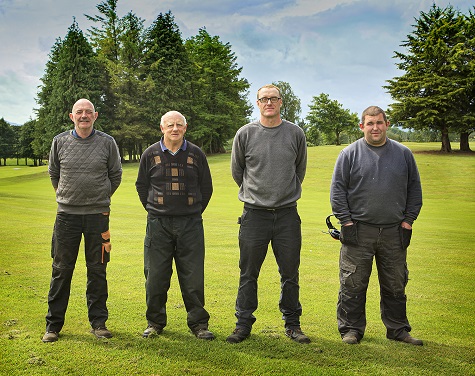
Greenkeeping staff from left: Tom Lawlor, Martin Kennedy, Mark O’Donohue, James Redden
Maintenance
Mark and the greenkeeping team maintain the course on a tight budget, which means that he has to make sure there is no wastage. He is very sparing on nutritional outputs and hasn’t used granular fertilizer for almost nine years. During the winter he dissolves sulphate of ammonia with sulphate of iron and sprays it on the greens. It keeps the greens ticking over during the winter with the iron giving the grass strength against diseases. This feeding pattern changes to using liquid urea from spring onwards sometimes changing to a liquid feed, depending on soil sample test results.
Preventative applications of fungicide are applied when weather conditions favour disease outbreak. Around 175 tonnes of sand is put out on the greens every year. Little and often is the method of application where greens are topdressed every two weeks throughout the year. With year round dry ground conditions this can easily be achieved at Nenagh.
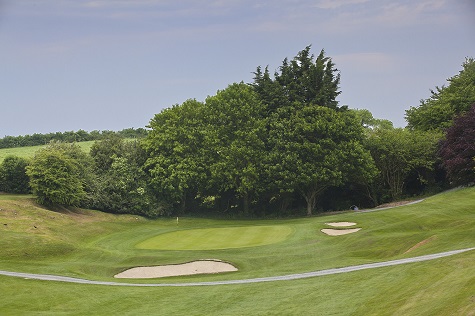
The original McKenzie 8th green dating back to 1929
In Spring and Autumn the greens are overseeded with an 80:20 mix of fescue and browntop bent. The height of cut for greens is 3.5 – 4mm in summer increasing to 6mm in winter. Surrounds and tees are cut at 12mm while fairways are mown at 16mm. The semi rough is maintained at 30mm (1.25 inches) while the rough is cut at 50mm (2 inches). Automatic irrigation is installed on tees and around greens.
A project that is planned for the future is to reduce the size of the bunkers around the course, some of which have already been filled in. When more work on the bunkers begin, any steep faced bunkers will be reduced. The idea of installing Ecobunkers to some of the bunkers is being thought of. This should minimise maintenance costs and time on bunkers.
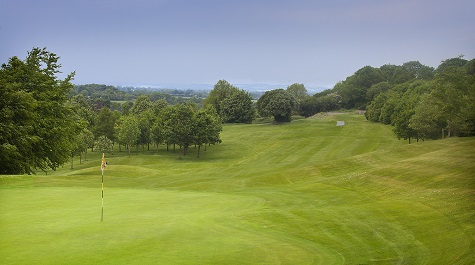
A view of the 13th hole
There is an area on the course where Mark and his staff have access to gravel. It is located beside an old small disused quarry, once used by a neighbouring farmer. If there are any areas on the course that need draining then this is the place where drainage stone can be sourced, saving the club a lot of money.
When the club opened for play in 1929, it was mainly open rolling countryside with some ferns and gorse. Most of the trees that are growing throughout the course were planted since then so there are no mature oak or beech trees. In a peculiar way this is an advantage for Mark and his team as they do not spend too much time during autumn/early winter blowing and gathering up leaves from the course. Someday though, in about thirty or forty years from now, it will be a headache for a future course superintendent.
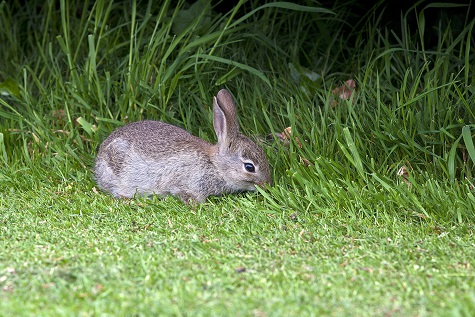
A young rabbit grazes unconcerned on one of the tees
In 2016 the club wanted some way of commemorating the centenary of the 1916 Easter Rising. Thomas McDonagh, one of the signatories of the proclamation, was born up the road in nearby Cloughjordan so the club feel there is a strong connection to the Easter Rising. They decided to plant seven beech trees, along with erecting a commemoration plaque near the putting green to commemorate the event.
The lockdowns of 2020 and 2021 provided some opportunity for Mark and his team to carry out some repairs and new projects on the course. Three tee boxes, the 7th, 8th and 15th, had developed crowns or ridges over many years of topdressing. Having no golfers on the course enabled Mark to strip the turf from these tee boxes, grade and level them and replace the turf back again without having the need to create temporary tee boxes.
After May 2020, when golfers were allowed return to the fairways after the first lockdown, Nenagh Golf Club saw a big increase in membership. It is thought that the reason for this was that the GAA clubs were still not fully opened and only limited to training with a restricted number of players. This would have left a need for people to take up golf as a way of getting in some exercise. The club wasn’t complaining as it brought in much needed income.
However, as we all know, golf clubs were forced to shut again in December 2020, due to another outbreak of Covid-19. Not allowing the grass to grow under their feet, Mark and his team took advantage, once again, of an empty course. Around 45 semi-mature trees were replanted. This involved hiring in a tree spade, which allowed for an efficient method of transplanting and also minimizing the amount of stress to the trees during transporting. The vast majority of them were still thriving when I visited the course in June.
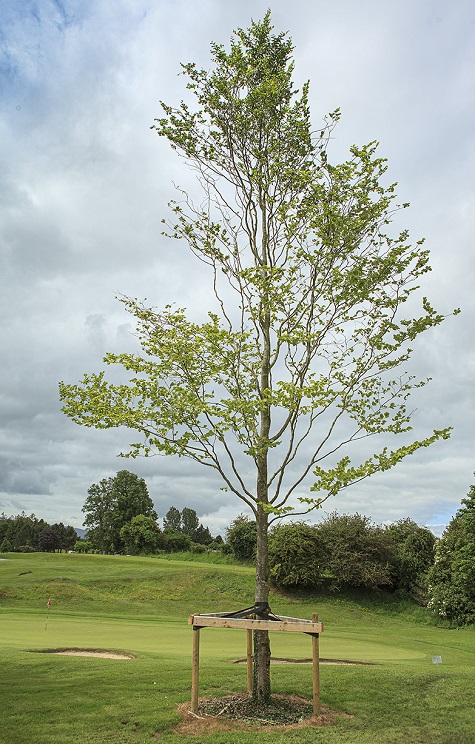
One of the semi-mature beech trees that were transplanted using a tree spade
Wildlife is encouraged on the course. There are many wild animals to be seen such as foxes, red squirrels, rabbits, badgers and buzzards. Some of the club officers came up with the idea of creating a bug hotel and putting it out in a non-playing area of the course. This was thought to be a good idea so they, and some volunteers, started the task of creating the bug hotel which was installed near the 8th hole.
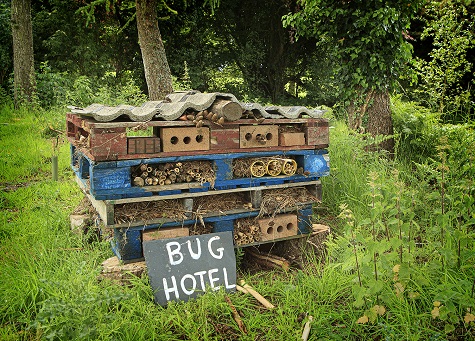
The bug hotel
Interesting facts
- During World War Two the club informed members that golf balls were to be rationed. An allowance of only two golf balls per member, per week was the rule. Given the state of the rough at the time it was not unusual to see members return to the clubhouse having not completed their rounds.
- In 1944 the assets of the club included a horse, valued at £39. Prior to this an animal was borrowed to cut the fairways and rough. In 1947 a gang-mower, valued at £166 was purchased, along with another horse. In 1949 the club bought a tractor valued at £77.
- In the early years the course was only open for play in the winter as it was handed over for grazing livestock during the summer months.
- The Revenue Statement for the year ended 31st December 1936 showed that £35 and 5 shillings was spent on the upkeep of the course.
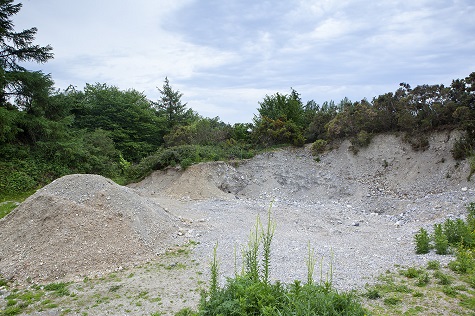
The quarry where gravel is used for drainage around the course